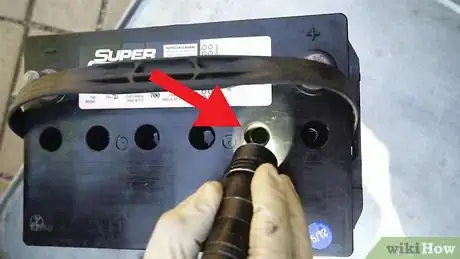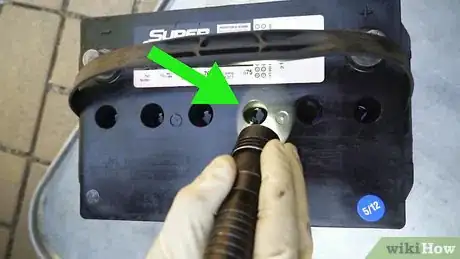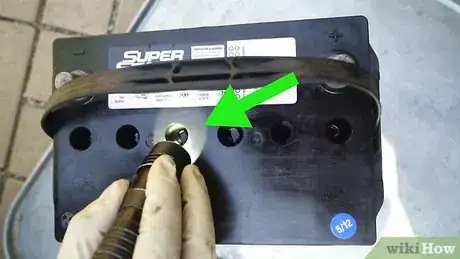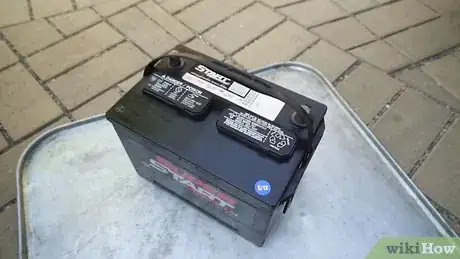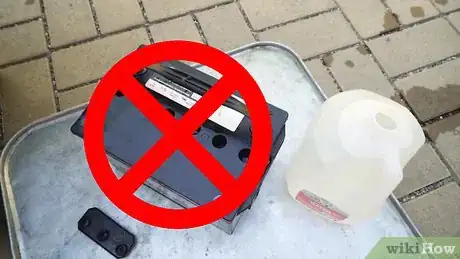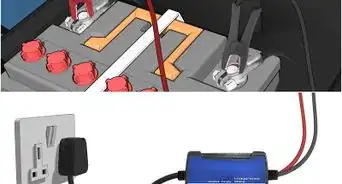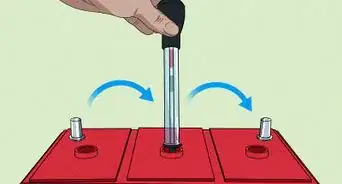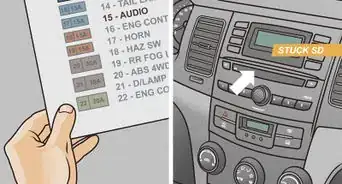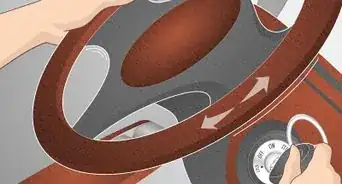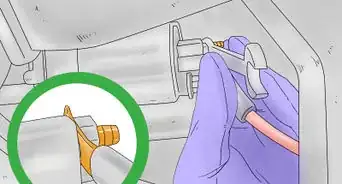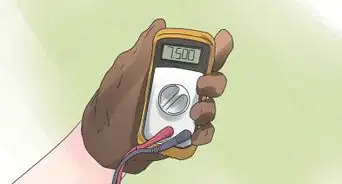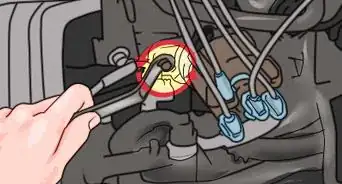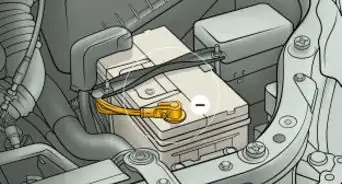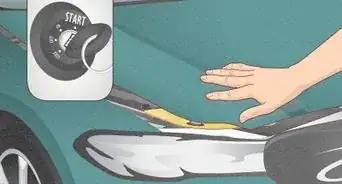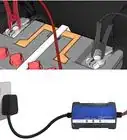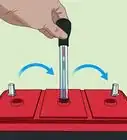This article was co-authored by Rocco Lovetere. Rocco Lovetere is the Owner and a Master Mechanic at Rocco's Mobile Auto Repair in California. With over 20 years of experience, he specializes in Honda, Acura, Toyota, Nissan, Infiniti, and Volvo cars. He is an ASE Certified Automotive technician and has worked in automotive repair since 1999.
There are 9 references cited in this article, which can be found at the bottom of the page.
wikiHow marks an article as reader-approved once it receives enough positive feedback. This article received 21 testimonials and 87% of readers who voted found it helpful, earning it our reader-approved status.
This article has been viewed 1,134,719 times.
Learning how to safely check the electrolyte levels in your car battery is an important aspect of car maintenance that should be performed a few times each year. Checking is important for two reasons: first, because electrolyte naturally evaporates and second, because a small amount electrolyzes into hydrogen and oxygen every time the battery charges.
Steps
Cleaning the Battery and Opening the Ports
-
1Locate the battery. In most cars, you simply need to open the hood of your car to access the battery.[1]
- Some batteries are located lower in the engine compartment, behind the front bumper and ahead of the front wheels. These are sometimes accessed from the bottom and need to be removed for service.
- Most BMW and Mercedes Benz batteries and a few others are located in the trunk, concealed in an isolated compartment.
- Batteries may also be located under the rear seat, such as in some Cadillacs.
-
2Clean. Before you check the water levels, clean any dirt or debris from the top of the battery and around the battery terminals. This is important, as you do not want any foreign material entering the battery cells when you open them. This is also important because a clean battery surface helps slow or stop corrosion on nearby metal.[2]
- For general cleaning of road grime and minor corrosion, use an ammonia-based window cleaner. Spray the cleaner on your rag — not on the battery itself — and wipe away any dirt. Paper towels can be used as long as you replace them before they disintegrate to bits.
- Heavy corrosion can be cleaned with a paste of baking soda and water. Again, wet the rag and wipe, do not soak the battery with baking soda. Sometimes it takes many repetitions of wetting the rag and wiping. Follow up by cleaning with a rag dampened with window cleaner to remove the baking soda. Leaving a residue of baking soda on the exterior of the battery will speed up future corrosion of the terminals and nearby metal.
- Don't get ahead of yourself here — be sure the covers are on the battery ports at this stage of cleaning. Do not let cleaning fluids drip or flow into the battery through the ports.
- Note: If you prefer, you can remove the battery from the car before cleaning and performing this maintenance, and reinstall it afterwards. This may be safer, especially if the battery is in an awkward location. This will reset some or all of the electronics in the car however (clock, radio station presets, etc.). If the battery can be serviced without removing it from the car, this usually saves considerable time overall.
- You can also remove the battery terminals from the battery and dip them in a cup of very hot water. The hot water will melt away the corrosion, leaving a clean surface. Make sure the terminals are completely dry before replacing them on the battery. (This will also reset the car's electronics.)
Advertisement -
3Open the ports. On top of the battery are typically two semi-rectangular plastic covers used to seal each battery cell port. These can be removed by gently prying with plastic putty knife or a screwdriver. Try prying from a number of points around the periphery of the cover if the cover does not immediately come loose.
- Some batteries have six individual round covers instead. These can be removed by twisting counter-clockwise, and then lifting them out.
- If the battery is labeled as "maintenance free," it is not designed to be opened. Manufacturers advise that water cannot be added to these batteries, they simply need to be replaced if they stop working well.
-
4Continue cleaning if necessary. Removing the port covers may reveal more dirt on the top of the battery. Continue cleaning by wiping away from the ports with a rag dampened with window cleaner.
- Do not use baking soda for this cleaning. Use a small amount of window cleaner, and be very careful to prevent anything (cleaner, dirt, bits of paper towel, etc.) from entering the ports.
- Don't be tempted to skip this step — keeping the top of the battery clean will reduce future corrosion. This is an important aspect of battery maintenance for preserving the integrity of the connections.
Assessing the Existing Fluid Levels
-
1Compare the fluid levels in each cell. By looking down into each port you can see the electrolyte level of each individual cell. Each cell is supposed to be covered in an equal amount of fluid.[3]
- If this is not the case it could have been caused simply by accidental overfilling previously, in which case the problem is easily corrected by proper filling later, after the overfilled level has gone down in normal service to the normal range.
- If fluid levels are obviously unequal, it is also possible that the battery may have a small fluid leak or a cracked case. If so the battery needs to be replaced. If there is no obvious leakage, fill the battery to the maximum safe level, using distilled water only, and check again in a few weeks to see if the levels have remained uniform.
-
2Recognize when electrolyte levels are low. The electrolyte is too low if any part of the plates is exposed to air. If the plates are not fully covered with electrolyte, then the battery cannot operate at full capacity.[4]
- Exposing the plates to air ruins the area exposed to air in a matter of days.
- If the electrolyte is only about 1/2 inch (1 cm) below the top of the plates, adding enough water to the battery to just cover the plates may return it to serviceable condition at a slightly reduced capacity. (Instructions for adding water follow in Part 3 of this wiki article.) Otherwise, you will need to consider replacing the battery.
- A low electrolyte level could be caused by overcharging, so if this is the case, you should consider having your alternator checked.
-
3Recognize when electrolyte levels are normal. The normal fluid level is about 1/2 inch (1 cm) above the tops of the plates or about 1/8 inch (3 mm) below the bottoms of the filler tubes that extend down from the port openings.
- If this is the case it may not be worth the effort to fill the battery at this time. Just replace the port covers and inspect again in three months.
-
4Recognize when the electrolyte is at its maximum level. The maximum safe fluid level is just touching the bottom of the filler tubes.
- Most filler tubes have a pair of slots in the side somewhere near the bottom of the tube. This causes the meniscus (the little bit of liquid that bends up near the edge of the tube) to have a distinctive eye-shape if the fluid is touching the filler tube, whereas there is no meniscus if the fluid is below the bottom of the filler tube.
- The eye-shaped meniscus is designed as a signal to stop filling. You may need to use a flashlight to see the fluid level and the presence or absence of the meniscus clearly.
-
5Keep in mind that these levels are for lead-acid automotive batteries only. You should always follow the advice of your battery dealer or the battery manufacturer if it conflicts with the information provided in this article.
- Also be aware that batteries for golf carts, floor cleaning machines, and nickel cadmium batteries especially may require other electrolyte levels.
Adjusting the Fluid Levels
-
1Use only distilled water to fill the cells. Distilled water can be purchased at most grocery stores. If the electrolyte levels in the cells are low (plates are exposed), fill each cell to just cover the plates. Then use a battery charger to recharge the battery, or just drive the car for a few days in normal service. Only fill to the maximum safe level — just touching the bottoms of the filler tubes — if the battery is fully charged.[5]
- Use a clean funnel, sports bottle, turkey baster, etc. to ensure control of the flow and accuracy of the final level when filling each port. Be very careful to prevent any dirt or cleaning agents from getting into the cells.
- Using tap water, well water, filtered water, or anything but distilled water, will introduce minerals and chemicals (e.g. chlorine if it is city water) and other contaminates that will result in decreased battery life.[6]
-
2If the battery is weak or dead, avoid filling the cells fully. If you are adding water because the battery is weak or dead, it is better to fill it just enough to cover the plates (or leave it alone if it is at a normal level).[7]
- When a weak or dead battery is charged the electrolyte level will rise, therefore you should allow space for the level to rise when you charge the battery. (This does not happen to a fully charged battery.)
- Electrolyte levels can also rise if the battery gets hot.
-
3Wipe up spills and close the ports. Ensure all areas are clean and free from dirt or debris, then place cleaned port covers back onto the battery.
- If you accidentally overfilled the battery but there is no overflow onto the top surface of the battery, the best thing to do is just to stop filling and let it be. If there was an overflow onto the top of the battery, remember that the overflow is acidic — do not let it touch your skin or clothing.
- Clean it with a rag or with paper towels by wiping away from the ports. Do not let the rag or paper towels get wet enough to drip on other parts of the car or anything. Rinse the rag or paper towel in a pail of water. Wear gloves—don't get the water on your hands.
- After the job is done, discard the rinsed-out rag or paper towel in the regular trash. Pour the water down a drain, being careful not to splash the water around. You do not want to take a chance that the residue of acid will get on something else. Finally, clean anything that the overflow contacted with a rag dampened with window cleaner.
- Visually inspect any overfilled battery weekly for a month to see if there is any further overflow, and clean any overflow as described above if necessary.
- The sulfuric acid lost from the battery by an accidental overflow is probably a small enough amount as to be immaterial to the operation of the battery. It is best not to attempt to add acid to to replace the loss. (Too much acid shortens the life of the battery more than too little.)
Taking Adequate Safety Precautions
-
1Protect your eyes by wearing safety goggles. The electrolyte in the battery is sulfuric acid, so it is extremely important that none of this liquid gets into your eyes, as it could cause significant damage or even blindness.[8]
- Contact lenses afford you no protection and may complicate an accident. Ordinary glasses do not protect adequately due to the lack of side shields.
- Therefore, it's essential to wear safety goggles, which can be purchased at most hardware stores.
-
2Protect your hands by wearing disposable gloves. Choose a glove-type that can stand up to sulfuric acid for at least a few minutes. These can be found at hardware stores.
- Latex and vinyl gloves will not stand up to acid long. If you use latex or vinyl gloves, change the glove immediately upon noticing a splash on it. Given time, a splash of electrolyte will soak through the glove and burn your skin.
- Neoprene gloves offer protection for an hour or more, but are harder to find at ordinary hardware stores. Nitrile is not the same as Neoprene. Nitrile gloves offer less protection from sulfuric acid than latex, and should not be used.
-
3Protect your skin. Wear old clothing with long sleeves, long pants, and closed toe shoes to cover as much skin as possible. If any electrolyte splashes on your clothing the fabric will rot away in about a week or two, leaving a hole, so wear old clothes that you can sacrifice.
-
4Know what to do if the electrolyte touches your skin. If any electrolyte splashes on your skin, immediately wash it with running water and soap.[9]
- If you feel a burning or tingling sensation on your skin anywhere, you may have splashed a drop of electrolyte on yourself. It only takes a drop to cause a burn.
- You may not be able to see any redness or injury until it is too late, so if you suspect you may have splashed yourself, take a break from your work and wash immediately rather than taking a chance.
- Dispose of all used gloves and rags when the job is done. Leaving these in contact with other materials could cause damage.
Things You'll Need
- Safety glasses
- Gloves. Neoprene is best. Latex or Vinyl are OK. Nitrile can't stand up to battery acid.
- Rags or paper toweling
- Distilled Water
- Sports bottle, turkey baster, or a funnel.
- Ammonia-based window cleaner
- Baking soda (optional--if heavy corrosion is present on the battery terminals)
- One inch wide plastic putty knife (optional) for prying off port covers, or carefully use a screwdriver with an insulated handle.
References
- ↑ http://www.clickmechanic.com/blog/where-is-my-car-battery-located/
- ↑ https://www.meineke.com/blog/how-to-clean-a-car-battery/
- ↑ https://www.howacarworks.com/electrical-systems/checking-the-batteries
- ↑ https://www.autoblog.com/2016/04/08/how-to-check-electrolyte-levels-in-your-battery/
- ↑ https://www.popularmechanics.com/cars/car-technology/a26549/car-battery-how-to/
- ↑ http://www.justbajan.com/cars/maintain/052501-01/printer.htm
- ↑ https://www.crownbattery.com/news/watering-your-lead-acid-battery-the-basics
- ↑ http://www.edmunds.com/car-technology/a-shocking-expose-your-cars-battery.html
- ↑ https://www.ccohs.ca/oshanswers/safety_haz/garages/batteries.html
About This Article
Before checking the water levels in your car’s battery, make sure to wear safety goggles and disposable gloves to protect your eyes and skin from the electrolytes in the battery. Then, clean off the dirt from the top of the battery and open the ports so you can check the fluid level in each cell. If the cells are not covered in an equal amount of fluid, you'll need to fill them with just enough water to cover the plates. Afterwards, wipe up any spills and place the port covers back onto the battery. For more advice from our Automotive reviewer, including how to adjust the fluid levels in your battery, read on!
